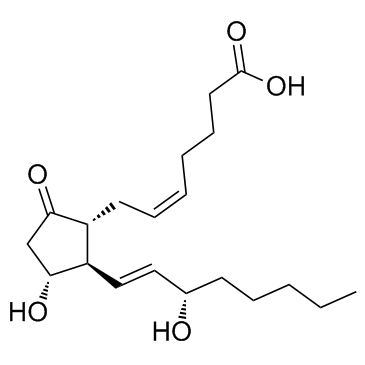Dinoprostone

Dinoprostone structure
|
Common Name | Dinoprostone | ||
|---|---|---|---|---|
| CAS Number | 363-24-6 | Molecular Weight | 352.465 | |
| Density | 1.1±0.1 g/cm3 | Boiling Point | 530.1±50.0 °C at 760 mmHg | |
| Molecular Formula | C20H32O5 | Melting Point | 66-68 °C | |
| MSDS | Chinese USA | Flash Point | 288.5±26.6 °C | |
| Symbol |


GHS07, GHS08 |
Signal Word | Danger | |
|
MLN4924 sensitizes monocytes and maturing dendritic cells for TNF-dependent and -independent necroptosis.
Br. J. Pharmacol. 172(5) , 1222-36, (2015) MLN4924 prevents the formation of active cullin-RING ubiquitin ligase complexes and thus inhibits NF-κB signalling. Here, we evaluated the effects of this compound on monocytes and dendritic cells (DCs).Monocytes and DCs were challenged with TNF or LPS in the... |
|
|
Isothiocyanate analogs targeting CD44 receptor as an effective strategy against colon cancer.
Med. Chem. Res. 23(8) , 3836-3851, (2014) Inflammatory pathway plays an important role in tumor cell progression of colorectal cancers. Although colon cancer is considered as one of the leading causes of death worldwide, very few drugs are available for its effective treatment. Many studies have exam... |
|
|
Unique characteristics of human mesenchymal stromal/progenitor cells pre-activated in 3-dimensional cultures under different conditions.
Cytotherapy 16(11) , 1486-500, (2014) Human mesenchymal stromal cells (MSCs) are being used in clinical trials, but the best protocol to prepare the cells for administration to patients remains unclear. We previously demonstrated that MSCs could be pre-activated to express therapeutic factors by ... |
|
|
HuR mediates the synergistic effects of angiotensin II and IL-1β on vascular COX-2 expression and cell migration.
Br. J. Pharmacol. 172 , 3028-42, (2015) Angiotensin II (AngII) and IL-1β are involved in cardiovascular diseases through the induction of inflammatory pathways. HuR is an adenylate- and uridylate-rich element (ARE)-binding protein involved in the mRNA stabilization of many genes. This study investi... |
|
|
Kaposi's sarcoma-associated herpesvirus induces Nrf2 activation in latently infected endothelial cells through SQSTM1 phosphorylation and interaction with polyubiquitinated Keap1.
J. Virol. 89(4) , 2268-86, (2015) Nuclear factor erythroid 2-related factor 2 (Nrf2), the cellular master regulator of the antioxidant response, dissociates from its inhibitor Keap1 when activated by stress signals and participates in the pathogenesis of viral infections and tumorigenesis. Ea... |
|
|
Activation of Mas Oncogene-Related G Protein-Coupled Receptors Inhibits Neurochemical Alterations in the Spinal Dorsal Horn and Dorsal Root Ganglia Associated with Inflammatory Pain in Rats.
J. Pharmacol. Exp. Ther. 354 , 431-9, (2015) Mas oncogene-related G protein-coupled receptor C (MrgC) is unequally expressed in sensory ganglia and has been shown to modulate pathologic pain. This study investigated the mechanism underlying the effect of MrgC receptors on inflammatory pain. Intrathecal ... |
|
|
Prostaglandin E2 promotes hepatocellular carcinoma cell invasion through upregulation of YB-1 protein expression.
Int. J. Oncol. 44(3) , 769-80, (2014) Prostaglandin E2 (PGE2) has been implicated in hepatocellular carcinoma cell invasion. Recently, it was reported that Y box-binding protein 1 (YB-1) is closely correlated with malignancy. This study was designed to examine the mechanisms by which PGE2 increas... |
|
|
Anti-inflammatory potential of newly synthesized 4-[(butylsulfinyl)methyl]-1,2-benzenediol in lipopolysaccharide-stimulated BV2 microglia.
Molecules 19(10) , 16609-23, (2014) In this study, we investigated the anti-inflammatory effects of newly synthesized 4-[(butylsulfinyl)methyl]-1,2-benzenediol (SMBD) in lipopolysaccharide (LPS)-stimulated BV2 microglia and the subsequent signaling events. Following stimulation with LPS, elevat... |
|
|
Chrysophanol affords neuroprotection against microglial activation and free radical-mediated oxidative damage in BV2 murine microglia.
Int. J. Clin. Exp. Med. 8 , 3447-55, (2015) In this study, chrysophanol, isolated from a marine fungus, was examined for its protective effects against inflammatory responses and oxidative stress in BV2 microglia. Chrysophanol was studied to assess its capabilities of protecting against lipopolysacchar... |
|
|
cis-Resveratrol produces anti-inflammatory effects by inhibiting canonical and non-canonical inflammasomes in macrophages.
Innate Immunity 20(7) , 735-50, (2014) Resveratrol, a natural phenolic compound found in red grapes and wine, exists as cis and trans isomers. Recent studies have shown that trans-resveratrol possesses anti-inflammatory, anti-oxidant, anti-carcinogenic, anti-tumor and immunomodulatory properties. ... |